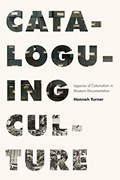Narrow Results By
Adjusting the lens : Indigenous activism, colonial legacies, and photographic heritage
https://archives.whyte.org/en/permalink/catalogue25525
- Medium
- Library - Book (including soft-cover and pamphlets)
- Published Date
- 2021
- Publisher
- Vancouver, British Columbia : University of British Columbia Press
- Call Number
- 07.2 L62a
- Responsibility
- Edited by Sigrid Lien and Hilde Wallem Nielssen
- Publisher
- Vancouver, British Columbia : University of British Columbia Press
- Published Date
- 2021
- Physical Description
- vi, 312 pages : illustrations (black & white) ; 24 cm
- Abstract
- Adjusting the Lens explores the role of photography in contemporary renegotiations of the past and in Indigenous art activism. In moving and powerful case studies, contributors analyze photographic practices and heritage related to Indigenous communities in Canada, Australia, Greenland, Norway, Sweden, Finland, and the United States. In the process, they call attention to how Indigenous people are using old photographs in new ways to empower themselves, revitalize community identity, and decolonize the colonial record. Adjusting the Lens presents original research in this emerging field in Indigenous photography studies, juxtaposing the historical and the contemporary across a range of geographically and culturally distinctive contexts. The transnational perspective of this exciting collection challenges old ways of thinking and meaningfully advances the crucially important project of reclamation. -- Provided by publisher
- Contents
- Reading a Regional Colonial Photographic Archive: Residential Schools in Southern Alberta, 1880-1974 / Carol Williams ; Camera Encounters: Bourgeois Settler Women's Adentures in Sami Areas of Norway / Sigrid Lien and Hilde Wallem Nielssen ; Negotiating Meaning: John Moller's Photographs in Early Twentieth-Century Scandinavian Literature / Ingeborg Hovik ; Reclaiming Pasts, Reclaiming Futures: Indigenous Re-workings of Historical Photography in North America / Laura Peers ; Distruption and Testimony: Archival Photographs, Project Naming, and Inuit Memory in Nunavut / Carol Payne, with contributions by Beth Greehorn, Piita Irniq, Manitok Thompson, Deborah Kigjugalik Webster, Sally Kate Webster, and Christina Williamson ; "Our Histories" in the Photographs of Others: Sami Approaches to Archival Visual Materials / Veli-Pekka Lehtola ; The Best Day for Me, Looking at These Old Photos: Returning Photographs to Australian Aboriginal and Torres Straight Islander People by Jane Lydon and Donna Oxenham ; On Being with (a Photograph of) Sugar Bush Womxn: Towards Anishinaabe Feminist Archival Research Methods / waaseyaa'sin Chrisitne Sy ; Indigenous Culture Jamming: Suohpanterror and the Art of Articulating a Sami Political Community by Laura Junka-Aikio ; Negotiating Postcolonial Identity: Photography as Archive, Collaborative Aesthetics, and Storytelling in Contemporary Greenland / Mette Sandbye ; Photographic Portraits as Dialogical Contact Zones: The Portrait Gallery of Sapmi - Becoming a Nation at the Arctic University Museum of Norway / Hanne Hammer Stein ; Photographic Studies and Indigenous Photographies: Some Thoughts on Categories, Assumptions, and Theories / Elizabeth Edwards
- ISBN
- 9780774866613
- Accession Number
- P2022.04
- Call Number
- 07.2 L62a
- Collection
- Archives Library
This material is presented as originally created; it may contain outdated cultural descriptions and
potentially offensive content.
Read more.
Ancestors : indigenous peoples of Western Canada in historic photographs
https://archives.whyte.org/en/permalink/catalogue25527
- Medium
- Library - Book (including soft-cover and pamphlets)
- Published Date
- 2021
- Publisher
- Edmonton, Alberta : University of Alberta Library
- Call Number
- 07.2 C24a
- 07.2 C24a copy 2
- Responsibility
- Edited by Sarah Carter and Inez Lightning
- Publisher
- Edmonton, Alberta : University of Alberta Library
- Published Date
- 2021
- Physical Description
- x, 188 pages : illustrations (some color) ; 23 x 24 cm
- Abstract
- This exhibition catalogue introduces historic photographs of Indigenous peoples of Western Canada from a collection housed at the University of Alberta's Bruce Peel Special Collections. The publication focuses on the ancestors represented in the collection and how their images continue to generate stories and meanings in the present. The selected photographs contribute to a richer, deeper understanding of the past. There is strength, character, persistence, determination, artwork, humour, dance, celebration, and so much more in the photographs. Some serve as records of cherished landscapes that may have been altered. Others provide links to ancestors: revered leaders, soldiers, healers, thinkers, and orators. The curators hope that the process of identifying the people in these photographs, only begun here, will continue. (Provided by Publisher)
- Contents
- Foreword / Chief Willie Littlechild ; The nature of the collection and its challenges ; Western Canada in the late Nineteenth and early Twentieth Centuries ; The aims of the curators ; The Exhibition
- ISBN
- 9781551954547
- Accession Number
- P2022.05
- Call Number
- 07.2 C24a
- 07.2 C24a copy 2
- Collection
- Archives Library
This material is presented as originally created; it may contain outdated cultural descriptions and
potentially offensive content.
Read more.
Authorized heritage : place, memory, and historic sites prairie Canada
https://archives.whyte.org/en/permalink/catalogue25510
- Medium
- Library - Book (including soft-cover and pamphlets)
- Published Date
- 2021
- Author
- Coutts, Robert
- Publisher
- Winnipeg, Manitoba : University of Manitoba Press
- Call Number
- 08.1 C83a
- Author
- Coutts, Robert
- Publisher
- Winnipeg, Manitoba : University of Manitoba Press
- Published Date
- 2021
- Physical Description
- 252 pages : illustrations, maps ; 23 cm
- Subjects
- Memory
- Heritage
- Historic sites
- Nationalism
- Colonialism
- Abstract
- Authorized Heritage analyses the history of commemoration at heritage sites across western Canada. Using extensive research in Parks Canada records, it argues that heritage narratives are almost always based on national and conventional messages that commonly reflect colonialist visions of the past. Throughout western Canada there are vivid examples of original and official views of what constitutes a national narrative. Yet many of the places that commemorate Indigenous, fur trade, and settler colonial histories are contested spaces, places such as Batoche, Seven Oaks, and Upper Fort Garry being the most obvious. At these heritage sites, Indigenous perceptions of the past confront the conventions of settler colonial history and denote the fluid cultural perspectives that must define the shifting ground of heritage space. Robert Coutts brings his many years of experience as a Parks Canada historian to this detailed examination of heritage sites across the prairies. He shows how the process of commemoration reflects social and cultural perspectives that privilege a confident and progressive national narrative. He also examines how class, gender, and sexuality often remain apart from the heritage discourse. Most notably, Authorized Heritage examines how governments became the mediators of what is heritage and, just as significantly, what is not. -- Provided by publisher
- Contents
- Landscapes of Memory in Prairie Canada ; Memory Hooks: Commemorating Indigenous Cultural Landscapes ; National Dreams: Commemorating the Fur Trade in Manitoba ; "We Came. We Toiled. God Blessed": Settler Colonialism and Constructing Authenticity ; Contested Space: Commemorating Indigenous Places of Resistance ; Heritage Place: The Function of Modernity, Gender, and Sexuality ; History, Memory, and the Heritage Discourse
- ISBN
- 9780887559266
- Accession Number
- P2022.02
- Call Number
- 08.1 C83a
- Collection
- Archives Library
This material is presented as originally created; it may contain outdated cultural descriptions and
potentially offensive content.
Read more.
Bead by bead : constitutional rights and Métis community
https://archives.whyte.org/en/permalink/catalogue25524
- Medium
- Library - Book (including soft-cover and pamphlets)
- Published Date
- 2021
- Publisher
- Vancouver, British Columbia : University of British Columbia Press
- Call Number
- 07.2 B71b
- Responsibility
- Edited by Yvonne Boyer and Larry Chartrand
- Publisher
- Vancouver, British Columbia : University of British Columbia Press
- Published Date
- 2021
- Physical Description
- xii, 221 pages ; 24 cm
- Subjects
- Indigenous
- Metis
- Canada
- Politics
- Colonialism
- Identity
- Abstract
- What does the phrase Me´tis peoples mean in constitutional terms? As lawyers and scholars dispute forms of Me´tis identity, and debate the nature and scope of Me´tis rights under the Canadian Constitution, understanding Me´tis experience of colonization is fundamental to achieving reconciliation. In Bead by Bead, contributors address the historical denial - at both federal and provincial levels - of outstanding Me´tis concerns and Aboriginal rights claims, in particular with respect to land, resources, and governance. Tackling such themes as ongoing colonial policies, the invisibility of Me´tis women in court decisions, identity politics, and racist legal principles, they uncover the troubling issues that plague Me´tis aspirations for a just future. This nuanced analysis of the parameters that current Indigenous legal doctrines place around Me´tis rights discourse moves beyond a one-size-fits-all definition of Me´tis or a uniform approach to Aboriginal rights. By raising critical questions about self-determination, colonization, kinship, land, and other essential aspects of Me´tis lived reality, these clear-eyed essays go beyond legal theorizing and create pathways to respectful, inclusive Me´tis-Canadian constitutional relationships. (Provided by Publisher)
- Contents
- Me´tis identity captured by law: struggles over use of the category Me´tis in Canadian law / Se´bastien Grammond ; Recognition and reconciliation: recent developments in Me´tis rights law / Thomas Isaac ; Shifting the status quo: the duty to consult and the Me´tis of British Columbia / Christopher Gall and Brodie Douglas ; The resilience of Me´tis title: rejecting assumptions of extinguishment / Karen Drake and Adam Gaudry ; Where are the women? Analyzing the three Me´tis Supreme Court of Canada decisions / Brenda L. Gunn ; Manitoba Me´tis Federation and Daniels: "post-legal" reconciliation and Western Me´tis / Jeremy Patzer ; Colonial ideologies: the denial of Me´tis political identity in Canadian law / D'Arcy Vermette ; Me´tis Aboriginal rights: four legal doctrines / Darren O'Toole ; Suzerainty, sovereignty, jurisdiction: the future of Me´tis ways / Signa A. Daum Shanks.
- ISBN
- 9780774865975
- Accession Number
- P2022.04
- Call Number
- 07.2 B71b
- Collection
- Archives Library
This material is presented as originally created; it may contain outdated cultural descriptions and
potentially offensive content.
Read more.
Blood memory : the tragic decline and improbable resurrection of the American Buffalo
https://archives.whyte.org/en/permalink/catalogue26204
- Medium
- Library - Book (including soft-cover and pamphlets)
- Published Date
- 2023
- Author
- Duncan, Dayton and Burns, Ken
- Publisher
- New York : Alfred A. Knopf
- Call Number
- 08 D91b
- Publisher
- New York : Alfred A. Knopf
- Published Date
- 2023
- Physical Description
- xvi, 329 pages : illustrations (chiefly color) ; 24 cm
- Subjects
- Buffalo
- Pablo-Allard buffalo round-up
- Conservation
- Indigenous
- Colonialism
- Environment
- Ecology
- Abstract
- The epic story of the buffalo in America, from prehistoric times to today--a moving and beautifully illustrated work of natural history. The American buffalo--our nation's official mammal-is an improbable, shaggy beast that has found itself at the center of many of our most mythic and sometimes heartbreaking tales. The largest land animals in the Western Hemisphere, they are survivors of a mass extinction that erased ancient species that were even larger. For nearly 10,000 years, they evolved alongside Native people who weaved them into every aspect of daily life; relied on them for food, clothing, and shelter; and revered them as equals. Newcomers to the continent found the buffalo fascinating at first, but in time they came to consider them a hindrance to a young nation's expansion. And in the space of only a decade they were slaughtered by the millions for their hides, with their carcasses left to rot on the prairies. Then, teetering on the brink of disappearing from the face of the earth, they would be rescued by a motley collection of Americans, each of them driven by different--and sometimes competing--impulses. This is the rich and complicated story of a young republic's heedless rush to conquer a continent, but also of the dawn of the conservation era--a story of America at its very best and worst -- Provided by publisher.
- Contents
- Part 1: The Trail to Extinction -- The Buffalo and the People -- Strangers -- Omen in the Skies -- The Iron Horse -- Kills Tomorrow -- Part 2: Back From the Brink -- A Death Wind for My People -- Just in the Nick of Time -- Changes of Heart -- Ghosts -- The Last Refuge -- Blood Memory -- Big Medicine.
- Notes
- Dayton Duncan ; based on a documentary film by Ken Burns ; written by Dayton Duncan ; with an introduction by Ken Burns ; picture research by Emily Mosher and Susan Shumaker ; design by Maggie Hinders.
- Whyte Museum archival collections utilized.
- ISBN
- 9780593537343
- Accession Number
- P2023.25
- Call Number
- 08 D91b
- Collection
- Archives Library
This material is presented as originally created; it may contain outdated cultural descriptions and
potentially offensive content.
Read more.
Brotherhood to nationhood : George Manuel and the making of the modern indian movement
https://archives.whyte.org/en/permalink/catalogue25528
- Medium
- Library - Book (including soft-cover and pamphlets)
- Published Date
- 2020
- Author
- McFarlane, Peter and Manuel, Doreen
- Publisher
- Toronto : Between the Lines
- Call Number
- 07.2 M16a
- Publisher
- Toronto : Between the Lines
- Published Date
- 2020
- Physical Description
- xxvi, 311 pages : illustrations ; 23 cm
- Subjects
- Indigenous
- History
- History-Canada
- Colonialism
- Politics
- Abstract
- George Manuel was the strategist and visionary behind the modern Indigenous movement in Canada. A three-time Nobel Peace Prize nominee, he laid the groundwork for what would become the Assembly of First Nations and was the founding president of the World Council of Indigenous Peoples. Authors Peter McFarlane and Doreen Manuel follow him on a riveting journey from his childhood on a Shuswap reserve through three decades of fierce and dedicated activism. In these pages, an all-new foreword by celebrated Mi'kmaq lawyer and activist Pam Palmater is joined by an afterword from Manuel's granddaughter, land defender Kanahus Manuel. This edition features new photos and previously untold stories of the pivotal roles that the women of the Manuel family played--and continue to play--in the battle for Indigenous rights.
- ISBN
- 9781771135108
- Accession Number
- P2021.02
- Call Number
- 07.2 M16a
- Collection
- Archives Library
This material is presented as originally created; it may contain outdated cultural descriptions and
potentially offensive content.
Read more.
Canada's place names and how to change them
https://archives.whyte.org/en/permalink/catalogue25683
- Medium
- Library - Book (including soft-cover and pamphlets)
- Published Date
- 2022
- Author
- Beck, Lauren
- Publisher
- Montreal, Quebec : Concordia University Press
- Call Number
- 02.1 B39c
- Author
- Beck, Lauren
- Publisher
- Montreal, Quebec : Concordia University Press
- Published Date
- 2022
- Physical Description
- ix, 251 pages ; 21 cm
- Abstract
- The first book to demonstrate how inadequately place names and visual emblems represent the presence of women, people of colour, and people living with disabilities, Canada’s Place Names and How to Change Them provides an illuminating overview of where these names came from and what they reflect. This book disentangles the distinct cultural, religious, and historical naming practices and visual emblems in Canada’s First Nations, provinces, territories, municipalities, and federal lands. Starting with a discussion of Indigenous place knowledge and naming practices from several Indigenous and Inuit groups spanning the country, it foregrounds the breadth of possible ways to name places. Lauren Beck then illustrates the naming practices introduced by Europeans and how they misunderstood, mis-rendered, and appropriated Indigenous place names, while scrutinizing the histories of Columbian names, missionary names, and the secular and commemorative names of the last two centuries. She studies key symbols and emblems such as maps, flags, and coats of arms as visual equivalents of place names to show whose identities powerfully inform Canada’s place nomenclature. This book also documents the policies and authorities that have traditionally governed the creation and modification of names and examines case studies of institutions and communities who have changed their names to demonstrate pathways to change.-- Provided by publisher.
- Contents
- Knowing in Place -- A Brief History of Settler-Colonial Naming Practices in Canada -- Gender and Canada’s Place Names -- Indigenous Names in a Settler-Colonial Context -- Marginalized Groups and Canada’s Place Names -- How to Discuss and Change Names.
- ISBN
- 9781988111391
- Accession Number
- P2023.01
- Call Number
- 02.1 B39c
- Location
- Reading Room
- Collection
- Archives Library
This material is presented as originally created; it may contain outdated cultural descriptions and
potentially offensive content.
Read more.
Cataloguing culture : legacies of colonialism in museum documentation
https://archives.whyte.org/en/permalink/catalogue25523
- Medium
- Library - Book (including soft-cover and pamphlets)
- Published Date
- 2022
- Author
- Turner, Hannah
- Publisher
- Vancouver, British Columbia : University of British Columbia
- Call Number
- 00 T85c
- Author
- Turner, Hannah
- Publisher
- Vancouver, British Columbia : University of British Columbia
- Published Date
- 2022
- Physical Description
- xiii, 243 pages : illustrations ; 24 cm
- Subjects
- Museums
- Cataloguing
- Colonialism
- Inclusion
- Abstract
- How does material culture become data? Why does this matter, and for whom? As the cultures of Indigenous peoples in North America were mined for scientific knowledge, years of organizing, classifying, and cataloguing--hardened into accepted categories, naming conventions, and tribal affiliations --much of it wrong. Cataloguing Culture examines how colonialism operates in museum bureaucracies. Using the Smithsonian's National Museum of Natural History as her reference, Hannah Turner organizes her study by the technologies framing museum work over 200 years: field records, the ledger, the card catalogue, the punch card, and eventually the database. She examines how categories were applied to ethnographic material culture and became routine throughout federal collecting institutions. As Indigenous communities encounter the documentary traces of imperialism while attempting to reclaim what is theirs, this timely work shines a light on access to and return of cultural heritage. -- Provided by publishe
- Contents
- Introduction: "The Making of Specimens Eloquent" ; Writing Desiderata: Defining Evidence in the Field ; On the Margins: Paper Systems of Classification ; Ordering Devices and Indian Files: Cataloguing Ethnographic Specimens ; Pragmatic Classification: The Routine Work of Description after 1950 ; Object, Specimen, Data: Computerization and the Legacy of Dirty Data ; Conclusion: A Museum Data Legacy for the Future
- ISBN
- 9780774863933
- Accession Number
- P2022.04
- Call Number
- 00 T85c
- Collection
- Archives Library
This material is presented as originally created; it may contain outdated cultural descriptions and
potentially offensive content.
Read more.
Cigarette nation : business, health, and Canadian smokers, 1930-1975
https://archives.whyte.org/en/permalink/catalogue26246
- Medium
- Library - Book (including soft-cover and pamphlets)
- Published Date
- 2021
- Author
- Robinson, Daniel J.
- Publisher
- Montreal ; Kingston ; London ; Chicago : McGill-Queen's University Press
- Call Number
- 08.1 R56c
- Author
- Robinson, Daniel J.
- Publisher
- Montreal ; Kingston ; London ; Chicago : McGill-Queen's University Press
- Published Date
- 2021
- Physical Description
- xiii, 338 pages : illustrations ; 24 cm.
- Subjects
- Canada
- History-Canada
- Health
- Health and Social Development
- Health and wellness
- Drugs
- Marketing
- Abstract
- In the 1950s, the causal link between smoking and lung cancer surfaced in medical journals and mainstream media. Yet the best years for the Canadian cigarette industry were still to come, as per capita cigarette consumption rose steadily in the 1960s and 1970s. In Cigarette Nation, Daniel Robinson examines the vibrant and contentious history of smoking to discover why Canadians continued to light up despite the publicized health risks. Highlighting the prolific marketing and advertising practices that helped make smoking a staple of everyday life, Robinson explores socio-cultural aspects of cigarette use from the 1930s to the 1950s and recounts the views and actions of tobacco executives, government officials, and Canadian smokers as they responded to mounting evidence that cigarette use was harmful. The persistence of smoking owes to such factors as product development, marketing and retailing innovation, public relations, sponsored science, and government inaction. Domestic and international tobacco firms worked to furnish Canadian smokers with hope and doubt - hope in the form of reassuring marketing, as seen with light and mild cigarette brands, and doubt by means of disinformation campaigns attacking medical research and press accounts that aligned cigarettes with serious disease. Drawing on a wide range of primary sources, including thousands of industry records released during a landmark tobacco class-action trial in 2015, Cigarette Nation documents in rich detail the history of one of Canada's foremost public health issues. -- Provided by publisher.
- Contents
- Depression-era cigarette marketing and smoking culture -- The gift of wartime cigarettes -- The incomparable cigarette -- Taxes, public smoking, and lung cancer -- Hope and doubt -- Marketing bonanza -- The view from Ottawa.
- ISBN
- 9780228005322
- Accession Number
- P2024.02
- Call Number
- 08.1 R56c
- Collection
- Archives Library
This material is presented as originally created; it may contain outdated cultural descriptions and
potentially offensive content.
Read more.
Dark days at noon : the future of fire
https://archives.whyte.org/en/permalink/catalogue26239
- Medium
- Library - Book (including soft-cover and pamphlets)
- Published Date
- 2022
- Author
- Struzik, Edward
- Publisher
- Montreal ; Kingston ; London ; Chicago : McGill-Queen's University Press
- Call Number
- 04 St8d
- Author
- Struzik, Edward
- Publisher
- Montreal ; Kingston ; London ; Chicago : McGill-Queen's University Press
- Published Date
- 2022
- Physical Description
- ix, 291 pages : illustrations (chiefly colour), colour map ; 27 cm
- Abstract
- The catastrophic runaway wildfires advancing through North America and other parts of the world are not unprecedented. Fires loomed large once human activity began to warm the climate in the 1820s, leading to an aggressive firefighting strategy that has left many of the continent's forests too old and vulnerable to the fires that many tree species need to regenerate. Dark Days at Noon provides a broad history of wildfire in North America, from pre-European contact to the present, in the hopes that we may learn from how we managed fire in the past, and apply those lessons in the future. As people continue to move into forested landscapes to work, play, live, and ignite fires--intentionally or unintentionally--fire has begun to take its toll, burning entire towns, knocking out utilities, closing roads, and forcing the evacuation of hundreds of thousands of people. Fire management in North America requires attention and cooperation from both sides of the border, and many of the most significant fires have taken place at the boundary line. Despite a clear lack of political urgency among political leaders, Edward Struzik argues that wildfire science needs to guide the future of fire management, and that those same leaders need to shape public perception accordingly. By explaining how society's misguided response to fire has led to our current situation, Dark Days at Noon warns of what may happen in the future if we do not learn to live with fire as the continent's Indigenous Peoples once did. -- Provided by publisher.
- Contents
- Introduction -- 1. Prelude to the dark days at noon -- 2. The fire triangle -- 3. More dark days coming -- 4. The big burn -- 5. Big burns in Canada -- 6. Paiute forestry -- 7. Fire suppression -- 8. The Civilian Conservation Corps -- 9. Canada's Conservation Corps -- 10. The fall of the Dominion Forest Service -- 11. The royal commission into wildfire -- 12. White man's fire -- 13. International co-operation -- 14. Blue moon and blue sun -- 15. Nuclear winter -- 16. Yellowstone: A turning point -- 17. Big and small grizzlies -- 18. Climate and the age of megafire -- 19. The holy shit fire -- 20. The Pyrocene -- 21. Nuclear winter: Part two -- 22. Owls and clear-cuts -- 23. Water on fire -- 24. The Arctic on fire -- 25. The big smoke -- 26. Fire news -- Conclusion.
- ISBN
- 9780228012092
- Accession Number
- P2024.02
- Call Number
- 04 St8d
- Collection
- Archives Library
This material is presented as originally created; it may contain outdated cultural descriptions and
potentially offensive content.
Read more.
Decolonizing sport
https://archives.whyte.org/en/permalink/catalogue26241
- Medium
- Library - Book (including soft-cover and pamphlets)
- Published Date
- 2023
- Publisher
- Halifax ; Winnipeg : Fernwood Publishing
- Call Number
- 07.2 F77d
- Responsibility
- Edited by Janice Forsyth, Christine O'Bonsawin, Russell Field, and Murray G. Phillips
- Publisher
- Halifax ; Winnipeg : Fernwood Publishing
- Published Date
- 2023
- Physical Description
- xi, 276 pages : illustrations ; 23 cm
- Subjects
- Canada
- History-Canada
- Education
- Sport
- Indigenous
- Indigenous Culture
- Indigenous People
- Indigenous Traditions
- Indigenous Customs
- Abstract
- The path to decolonization is difficult and complex, and can even be contradictory at times, as when an Indigenous community enlists the same corporate sponsor that will destroy its natural environment to provide sport programming for its youth. There is no easy way forward. The Black Lives Matter movement, and their massive followers on social media, propelled forward discussions about the inequities that Covid-19 highlighted with unprecedented momentum. Indigenous people in Canada voiced their concerns in solidarity, calling attention to disparities they faced in everything from impoverished Indigenous health care initiatives to the overrepresentation of Indigenous people in the Canadian justice system, demanding to be heard alongside systemic change. Structural adjustments were afoot, including changes in the professional sport leagues. In both the United States and Canada, people witnessed the toppling of racist sports team names and logos in the spring and summer, not the least of which included the American Washington NFL team (Redskins) and the Canadian Edmonton CFL team (Eskimos). Clearly Indigenous people and their allies saw sport as a part of this desire for social change. This multi-authored collection contributes to that desire by bringing the work of Indigenous and non-Indigenous allied scholars together to explore the history of sport, physical activity, and embodied physical culture in the Indigenous context. Including chapters that address Indigenous topics beyond the political boundaries of Canada, including the US, Australia, New Zealand/Aotearoa, and Kenya, this collection considers questions such as: How can the history of sport (a colonizing practice with European origins) exist in dialogue with Indigenous voices to open up possibilities for reconsidering the history of modern sport? How can Indigenous and anti-oppressive research methodologies/methods inform the study of sport history? What are the ethics and responsibilities associated with conducting an Indigenous sport or recreation history? How can sport history as a discipline be open to the study of traditional land-based recreation? How can the meanings of "sport" be made more inclusive to include a variety of recreational practices? How can sport historians learn from histories of colonization and how can they contribute to a more reciprocal approach to knowledge formation through Indigenous community engagement? How can the discipline of sport history meaningfully support movements of Indigenous resurgence, regeneration, and decolonization? -- Provided by publisher.
- Contents
- Ways of knowing: sport, colonialism, and decolonization / Janice Forsyth, Christine O'Bonsawin, Russell Field -- Beyond competition: an Indigenous perspective on organized sport / Brian Rice -- More than a mascot: how the mascot debate erases Indigenous people in sport / Natalie Welch -- Witnessing painful pasts: understanding images of sports at Canadian Indian residential schools / Taylor McKee and Janice Forsyth -- The absence of Indigenous moving bodies: whiteness and decolonizing sport history / Malcolm MacLean -- # 87: using Wikipedia for sport reconciliation / Victoria Paraschak -- Olympism at face value: the legal feasibility of Indigenous-led Olympic Games / Christine O'Bonsawin -- Canoe racing to fishing guides: sport and settler colonialism in Mi'kma'ki / John Reid -- Transcending colonialism?: rodeos and racing in Lethbridge / Robert Kossuth -- "Men pride themselves on feats of endurance": masculinities and movement cultures in Kenyan running history / Michelle M. Sikes -- Stealing, drinking, and not cooperating: sport and everyday resistance in Aboriginal settlements in Australia / Gary Osmond -- Let's make baseball!: practices of unsettling on the recreational ball diamonds of Tkaronto/Toronto / Craig Fortier and Colin Hastings -- Subjugating and liberating at once: Indigenous sport history as a double-edge sword / Brendan Hokowhitu.
- ISBN
- 9781773636344
- Accession Number
- P2024.02
- Call Number
- 07.2 F77d
- Collection
- Archives Library
This material is presented as originally created; it may contain outdated cultural descriptions and
potentially offensive content.
Read more.
Dominion : the railway and the rise of Canada
https://archives.whyte.org/en/permalink/catalogue26203
- Medium
- Library - Book (including soft-cover and pamphlets)
- Published Date
- 2023
- Author
- Bown, Stephen R.
- Publisher
- [Toronto] : Doubleday Canada
- Call Number
- 08.5 B68d
- Author
- Bown, Stephen R.
- Publisher
- [Toronto] : Doubleday Canada
- Published Date
- 2023
- Physical Description
- 400 pages, 8 unnumbered pages of plates : illustrations, maps ; 25 cm
- Abstract
- Stephen R. Bown continues to revitalize Canadian history with this thrilling account of the engineering triumph that created a nation. In The Company, his bestselling work of revisionist history, Stephen Bown told the dramatic, adventurous and bloody tale of Canada's origins in the fur trade. With Dominion he continues the nation's creation story with an equally thrilling and eye-opening account of the building of the Canadian Pacific Railway. In the late 19th century, demand for fur was in sharp decline. This could have spelled economic disaster for the venerable Hudson's Bay Company. But an idea emerged in political and business circles in Ottawa and Montreal to connect the disparate British colonies into a single entity that would stretch from the Atlantic to the Pacific. With over 3,000 kilometers of track, much of it driven through wildly inhospitable terrain, the CPR would be the longest railroad in the world and the most difficult to build. Its construction was the defining event of its era and a catalyst for powerful global forces. The times were marked by greed, hubris, blatant empire building, oppression, corruption and theft. They were good for some, hard for most, disastrous for others. The CPR enabled a new country, but it came at a terrible price. In recent years Canadian history has been given a rude awakening from the comforts of its myths. In Dominion, Stephen Bown again widens our view of the past to include the adventures and hardships of explorers and surveyors, the resistance of Indigenous peoples, and the terrific and horrific work of many thousands of labourers. His vivid portrayal of the powerful forces that were molding the world in the late 19th century provides a revelatory new picture of modern Canada's creation as an independent state."-- Provided by publisher.
- ISBN
- 9780385698726
- Accession Number
- P2023.25
- Call Number
- 08.5 B68d
- Collection
- Archives Library
This material is presented as originally created; it may contain outdated cultural descriptions and
potentially offensive content.
Read more.
Educating the body : a history of physical education in Canada
https://archives.whyte.org/en/permalink/catalogue26240
- Medium
- Library - Book (including soft-cover and pamphlets)
- Published Date
- 2024
- Author
- Hall, M. Ann, Kidd, Bruce and Vertinsky, Patricia
- Publisher
- Toronto ; Buffalo ; London : University of Toronto Press
- Call Number
- 08.1 H14e
- Publisher
- Toronto ; Buffalo ; London : University of Toronto Press
- Published Date
- 2024
- Physical Description
- xvi, 305 pages : illustrations ; 26 cm
- Abstract
- The thesis of this work sets out a history of physical education in Canada with a focus on the major advocates, innovators, and institutions that helped shaped it. This work places the historical narrative within the social, economic, and political conditions that impacted institutions, advocates, and innovators as they influenced the formulation of state physical education schooling in Canada between the Ryerson era (1803-1882) and ending with the early decades of the 21st century. The title of the work, "Educating the Body" recognizes that "the body" has its own unique vocabulary and analysis, and as such, reflects the authors' belief that physical education curriculum should ideally enable the learner to direct their own discovery of body agency (and the joy of movement) in ways that are creative, self-expressive and true to their lived body experience. As the work demonstrates, however, waves of state-directed physical education curriculum each held their own agenda about how the "ideal" child and adolescent body should be trained within the context of hegemonic paradigms of dominance and control. The work is framed around three major developments that shape the analysis: a) the significant growth of critical, social scientific research about physical education and sport during the last 50 years (through the lens of social, material, feminist, post-structuralist and queer theory); b) the tensions underlying the evolution of kinesiology and the "displacement" (p. 13) of physical education as a school subject; and c) evidence from the Final Report of the Truth and Reconciliation Commission of Canada. -- Provided by publisher.
- Contents
- Ryerson and His Vision -- Towards a Pan-Canadian Curriculum -- The Margaret Eaton School: Forty Years of Women's Physical Education -- Fit for Living -- Setting a Heroic Agenda--Realizing the Possibilities -- Changing Times and New Initiatives -- Seeking Optimism in a Contested Field.
- ISBN
- 9781487508562
- Accession Number
- P2024.02
- Call Number
- 08.1 H14e
- Collection
- Archives Library
This material is presented as originally created; it may contain outdated cultural descriptions and
potentially offensive content.
Read more.
Edward Feuz Jr. : a story of enchantment
https://archives.whyte.org/en/permalink/catalogue25535
- Medium
- Library - Book (including soft-cover and pamphlets)
- Published Date
- 2021
- Author
- Stephen, D. L.
- Publisher
- Victoria, British Columbia : Rocky Mountain Books
- Call Number
- 08.3 Stem4e
- Author
- Stephen, D. L.
- Publisher
- Victoria, British Columbia : Rocky Mountain Books
- Published Date
- 2021
- Physical Description
- 318 pages
- Subjects
- Feuz, Edward
- Mountaineering
- Mountaineers, Swiss
- Guide
- Swiss Guides Village, Edelweiss, B.C.
- Tourism
- History-Canada
- Rocky Mountains
- Abstract
- As a young Swiss boy, Edward Feuz Jr. (1884–1981) developed an insatiable passion for climbing. In time, he traded his Lausbub reputation for that of a responsible Swiss guide and was eventually drawn to Canada in the footsteps of his father, Edward Feuz Sr. (1859–1944), who was one of the first Swiss guides hired by the Canadian Pacific Railway in 1898 to develop the alpinism in western Canada. Handsome and charismatic, Edward (while still in training for his trade) was instantly smitten with the Canadian landscape — and so were his guests. They raved about the young man who showed such exceptional skills. He guided them all — professors, women of independent means, students, newspaper people, a Hindu holy man, and even “Sherlock Holmes” — through untrailed forests, across roaring streams, up icy glaciers, and to the tops of rocky summits. Young and old, they were all enchanted, and so they returned time and again — to the mountains and to their friend Edward. -- From back cover
- Contents
- Pilgrims ; Edward ; How it All Began ; How we came to Share the Enchantment ; Feuz Haus ; How They Did It ; Reading the Signs ; Snapshots ; Life with Edward ; Edward's Girls
- ISBN
- 9781771605090
- Accession Number
- 2021.41
- Call Number
- 08.3 Stem4e
- Location
- Reading Room
- Collection
- Archives Library
This material is presented as originally created; it may contain outdated cultural descriptions and
potentially offensive content.
Read more.
Howdy, I'm John Ware : and this is the story of my cowboy life
https://archives.whyte.org/en/permalink/catalogue25246
- Medium
- Library - Book (including soft-cover and pamphlets)
- Published Date
- 2020
- Author
- Clough, Ayesha
- Rookwood, Hugh
- Publisher
- Carstairs, Alberta, Canada : Red Barn Books
- Call Number
- 08.1 C62h
1 website
- Author
- Clough, Ayesha
- Rookwood, Hugh
- Responsibility
- Ayesha Clough (author)
- Hugh Rookwood (illustrator)
- Publisher
- Carstairs, Alberta, Canada : Red Barn Books
- Published Date
- 2020
- Physical Description
- 39 pages : chiefly colour illustrations, colour maps, portraits
- Abstract
- Howdy, I’m John Ware is a children's book about Canada's legendary Black cowboy. The story, ideal for ages 6-12, brings the real-life legend to a new generation of kids. Despite experiencing enslavement, war and discrimination, this gifted horseman blazed a trail of kindness, becoming one of Alberta’s most loved and respected pioneer ranchers. (From publisher's website)
- ISBN
- 9781999108786
- Accession Number
- P2020.07
- Call Number
- 08.1 C62h
- Collection
- Archives Library
- URL Notes
- Publisher's website
Websites
This material is presented as originally created; it may contain outdated cultural descriptions and
potentially offensive content.
Read more.
Indigenous resurgence in an age of reconciliation
https://archives.whyte.org/en/permalink/catalogue26196
- Medium
- Library - Book (including soft-cover and pamphlets)
- Published Date
- 2023
- Publisher
- Toronto [Ontario] ; Buffalo ; London : University of Toronto Press
- Call Number
- 07.2 St2i
- Responsibility
- Edited by Heidi Kiiwetinepinesiik Stark, Aime´e Craft, and Hokulani K Aikau
- Publisher
- Toronto [Ontario] ; Buffalo ; London : University of Toronto Press
- Published Date
- 2023
- Physical Description
- vi, 263 pages : illustrations ; 23 cm
- Subjects
- Indigenous Culture
- Indigenous Customs
- Indigenous People
- Indigenous Traditions
- Reconciliation
- Colonialism
- Identity
- Gender
- Abstract
- What would Indigenous resurgence look like if the parameters were not set with a focus on the state, settlers, or an achievement of reconciliation? Indigenous Resurgence in an Age of Reconciliation explores the central concerns and challenges facing Indigenous nations in their resurgence efforts, while also mapping the gaps and limitations of both reconciliation and resurgence frameworks. The essays in this collection centre the work of Indigenous communities, knowledge, and strategies for resurgence and, where appropriate, reconciliation. The book challenges narrow interpretations of indigeneity and resurgence, asking readers to take up a critical analysis of how settler colonial and heteronormative framings have infiltrated our own ways of relating to our selves, one another, and to place. The authors seek to (re)claim Indigenous relationships to the political and offer critical self-reflection to ensure Indigenous resurgence efforts do not reproduce the very conditions and contexts from which liberation is sought. Illuminating the interconnectivity between and across life in all its forms, this important collection calls on readers to think expansively and critically about Indigenous resurgence in an age of reconciliation.-- Provided by publisher.
- Contents
- Artist Statement / Lianne Marie Leda Charlie -- Introduction: Generating a Critical Resurgence Together / Heidi Kiiwetinepinesiik Stark-- Part 1: Realizing Resurgence Together. 1. Beyond the Grammar of Settler Apologies / Mishuana Goeman -- 2. Spirit and Matter: Resurgence as Rising and (Re)creation as Ethos / Dian Million -- 3. Removing Weeds so Natives Can Grow: A Metaphor Reconsidered / Hokulani K. Aikau -- 4. (Ad)dressing Wounds: Expansive Kinship Inside and Out / Dallas Hunt -- Part 2: Claiming Our Relationships to the Political. 5. Beyond Rights and Wrongs: Towards Resurgence of a Treaty-Based Ethic of Relationality / Gina Starblanket -- 6. Thawing the Frozen Rights Theory: On Rejecting Interpretations of Reconciliation and Resurgence That Define Indigenous Peoples as Frozen in a Pre-colonial Past / Aimée Craft -- 7. Nêhiyaw Hunting Pedagogies and Revitalizing Indigenous Laws / Darcy Lindberg -- Part 3: Narrating Reconciliation and Resurgence. 8. Thinking through Resurgence Together: A Conversation between Sarah Hunt/Tlalilila’ogwa and Leanne Betasamosake Simpson / Sarah Hunt/Tlalilila’ogwa and Leanne Betasamosake Simpson -- 9. Truth-Telling amidst Reconciliation Discourses: How Stories Reshape Our Relationships / Jeff Corntassel -- 10. Political Action in the Time of Reconciliation / Corey Snelgrove and Matthew Wildcat -- Part 4: Reconciling Lands, Bodies, and Gender. 11. Body Land, Water, and Resurgence in Oaxaca / Isabel Altamirano-Jiménez -- 12. To Respect Indigenous Territorial Protocol: Hosting the Olympic Games on Indigenous Lands in Settler Colonial Canada / Christine O’Bonsawin -- 13. “Descendants of the Original Lords of the Soil”: Gender, Kinship, and an Indignant Model of Métis Nationhood / Daniel Voth -- 14. Red Utopia / Billy-Ray Belcourt.
- ISBN
- 9781487544607
- Accession Number
- P2023.10
- Call Number
- 07.2 St2i
- Collection
- Archives Library
This material is presented as originally created; it may contain outdated cultural descriptions and
potentially offensive content.
Read more.
Inhabited : wildness and the vitality of the land
https://archives.whyte.org/en/permalink/catalogue25571
- Medium
- Library - Book (including soft-cover and pamphlets)
- Published Date
- 2021
- Author
- Phillip Vannini and April Vannini
- Publisher
- Montreal ; Kingston ; London ; Chicago : McGill-Queen's University Press
- Call Number
- 04 V33i
- Publisher
- Montreal ; Kingston ; London ; Chicago : McGill-Queen's University Press
- Published Date
- 2021
- Physical Description
- 260 pages : illustrations ; 23 cm
- Abstract
- People are key elements of wild places. At the same time, human entanglements with wild ecologies involve extractivism, the growth of resource-based economies, and imperial-colonial expansion, activities that are wreaking havoc on our planet. Through an ethnographic exploration of Canada's ten UNESCO Natural World Heritage sites, Inhabited reflects on the meanings of wildness, wilderness, and natural heritage. As we are introduced to local inhabitants and their perspectives, Phillip Vannini and April Vannini ask us to reflect on the colonial and dualist assumptions behind the received meaning of wild, challenging us to reimagine wildness as relational and rooted in vitality. Over the three years they spent in and around these sites, they learned from Indigenous and non-Indigenous peoples about their entanglements with each other and with non-human animals, rocks, plants, trees, sky, water, and spirits. The stories, actions, and experiences they encountered challenge conventional narratives of wild places as uninhabited by people and disconnected from culture and society. While it might be tempting to dismiss the idea of wildness as outdated in the Anthropocene era, Inhabited suggests that rethinking wildness suggests a better - if messier - way forward. Part geography and anthropology, part environmental and cultural studies, and part politics and ecology, Inhabited balances a genuine love of nature's vitality with a culturally responsible understanding of its interconnectedness with more-than-human ways of life.-- Provided by publisher
- Contents
- Vitality and Relationality ;Ecological Heritage ; Interlude: Fog ; Entanglement ; Intensity ; Inhabitation ; Interlude: Bear Spray ; Atmosphere ; Interlude: The Lonsome Loon ; Exhaustion ; Interlude : NOT Alone ; Aliveness ; Sacred Ways of Life
- ISBN
- 9780228008965
- Accession Number
- P2022.13
- Call Number
- 04 V33i
- Collection
- Archives Library
This material is presented as originally created; it may contain outdated cultural descriptions and
potentially offensive content.
Read more.
Intimate integration : a history of the Sixties Scoop and the colonization of Indigenous kinship
https://archives.whyte.org/en/permalink/catalogue25725
- Medium
- Library - Book (including soft-cover and pamphlets)
- Published Date
- 2021
- Author
- Stevenson, Allyson D.
- Publisher
- Toronto, Ontario ; Buffalo, New York ; London, England : University of Toronto Press
- Call Number
- 07.2 S4i
- Author
- Stevenson, Allyson D.
- Publisher
- Toronto, Ontario ; Buffalo, New York ; London, England : University of Toronto Press
- Published Date
- 2021
- Physical Description
- xv, 328 pages : illustrations, maps, portraits ; 24 cm.
- Abstract
- Privileging Indigenous voices and experiences, Intimate Integration documents the rise and fall of North American transracial adoption projects, including the Adopt Indian and Me´tis Project and the Indian Adoption Project. The author argues that the integration of adopted Indian and Me´tis children mirrored the new direction in post-war Indian policy and welfare services. She illustrates how the removal of Indigenous children from Indigenous families and communities took on increasing political and social urgency, contributing to what we now call the "Sixties Scoop." Intimate Integration utilizes an Indigenous gender analysis to identify the gendered operation of the federal Indian Act and its contribution to Indigenous child removal, over-representation in provincial child welfare systems, and transracial adoption. Specifically, women and children's involuntary enfranchisement through marriage, as laid out in the Indian Act, undermined Indigenous gender and kinship relationships. Making profound contributions to the history of settler-colonialism in Canada, Intimate Integration sheds light on the complex reasons behind persistent social inequalities in child welfare. -- Provided by publisher
- Contents
- Bleeding heart of settler colonialism -- Adoptive kinship and belonging -- Rehabilitating the "subnormal [Me´tis] family" in Saskatchewan -- Green Lake Children's Shelter experiment : from institutionalization to integration in Saskatchewan -- Post-war liberal citizenship and the colonization of Indigenous kinship -- Child welfare as system and lived experience -- Saskatchewan's Indigenous resurgence and the restoration of Indigenous kinship and caring -- Confronting cultural genocide in the 1980s -- Conclusion : Intimate Indigenization -- Epilogue : Coming home -- Appendix: Road allowance communities in Saskatchewan.
- ISBN
- 9781487520458
- Accession Number
- P2023.12
- Call Number
- 07.2 S4i
- Collection
- Archives Library
This material is presented as originally created; it may contain outdated cultural descriptions and
potentially offensive content.
Read more.
Journey north : the Inuit Art Centre Project = Aullaaniq Ukiuqtaqtuq : Inuit Sabanguaganut Iglurjuaq Piliaksaq
https://archives.whyte.org/en/permalink/catalogue25677
- Medium
- Library - Book (including soft-cover and pamphlets)
- Published Date
- 2021
- Author
- Borys, Stephen D.
- Publisher
- Winnipeg, Manitoba : Winnipeg Art Gallery
- Call Number
- 06 B65j
- Author
- Borys, Stephen D.
- Publisher
- Winnipeg, Manitoba : Winnipeg Art Gallery
- Published Date
- 2021
- Physical Description
- 285 pages : illustrations (chiefly colour), portraits (chiefly colour) ; 30 cm
- Subjects
- Art galleries
- culture
- Museum
- Inuit
- History-Canada
- Abstract
- To commemorate the official opening of the Inuit Art Centre, now named Qaumajuq, Winnipeg Art Gallery Director and CEO, Dr. Stephen Borys, set out to share the story of this extraordinary museum and building project. His book, Journey North: The Inuit Art Centre Project, traces the history of the centre beginning with the establishment of the Winnipeg Art Gallery in 1912, when the foundation was laid to support a diverse and far-reaching mission that could embrace both historical and contemporary artmaking on national and international levels. By the time director Dr. Ferdinand Eckhardt arrived at the gallery in 1953, and discovered Inuit stone carving at the Hudson's Bay Company department store located across the street from the WAG, the idea of assembling a collection to celebrate this Indigenous art form moved closer to reality. This account of the development of the Inuit Art Centre includes different historical and contemporary perspectives and voices through a compilation of texts and images. In addition to the key essay by the book's author Stephen Borys, several writers from across the country have shared their stories about the gallery, the Inuit art collection, and the building project. In addition to the essays and the architectural renderings of the Inuit Art Centre by Michael Maltzan, the book also includes: a selection of Arctic photographs taken by Hazel Mouzon Borys and Iwan Baan, a series of construction images by Winnipeg Free Press photographers Mike Sudoma and Mike Deal, and finished building photographs by Jacqueline Young. -- Provided by publisher.
- Contents
- Message from the title sponsor / Ernest Cholakis -- Foreword / Natan Obed -- Message from the Chair / Ernest Cholakis -- Acknowledgements / Stephen Borys -- Qaumajuq: a name for the Inuit Art Centre / Julia LaFreniere -- Introduction / Stephen Borys -- A journey north / Stephen Borys -- Midnight sunlight / Iwan Baan -- Reflections on a curatorial journey / Darlene Coward Wight -- Origins / Abraham Anghik Ruben -- Multiple visions, magnificent reality / Patricia Bovey -- A vault into visibility : personal reflections / Richard Yaffe -- Museum encounters of another kind : indigenous methodologies of collaboration lead the charge / Julie Nagam -- Selecting an architect for the Inuit Art Centre / George Baird -- Characteristics and context / Michael Malitzan -- Biindigin Biwaasaeyaah and Qaumajuq : conversations and collaborations towards a new Winnipeg Art Gallery / Heather Igloliorte and Julie Nagam -- Winnipeg : a new cultural capital for Inuit art / Pat Feheley -- Moments of kindness and reconciliation : a new understanding for Inuit culture / Barry Appleton -- Building photography -- Contributors.
- ISBN
- 9781773070032
- Accession Number
- 2022.27
- Call Number
- 06 B65j
- Collection
- Archives Library
This material is presented as originally created; it may contain outdated cultural descriptions and
potentially offensive content.
Read more.
Liquor and the liberal state : drink and order before prohibition
https://archives.whyte.org/en/permalink/catalogue26245
- Medium
- Library - Book (including soft-cover and pamphlets)
- Published Date
- 2022
- Author
- Malleck, Dan
- Publisher
- Vancouver, BC : UBC Press
- Call Number
- 08.1 M29l
- Author
- Malleck, Dan
- Publisher
- Vancouver, BC : UBC Press
- Published Date
- 2022
- Physical Description
- xiv, 399 pages : illustrations ; 24 cm
- Subjects
- Canada
- History-Canada
- Prohibition
- Law
- Law enforcement
- Abstract
- Cultural pastime, profitable industry, or harmful influence on the nation? Liquor was a tricky issue for municipal, provincial, and federal governments after Confederation. Liquor and the Liberal State traces the takeover of liquor regulation by the Ontario provincial government in the late nineteenth and early twentieth centuries. Dan Malleck explores how notions of individual freedom, equality, and property rights were debated, challenged, and modified in response to an active prohibitionist movement and equally active liquor industry. While the liquor licensing regime helped build a vast patronage base for the governing Liberal Party, some believed it exceeded the constitutional authority of the provinces. The drink question became as political as it was moral - a key issue in the establishment of judicial definitions of provincial and federal rights, and, ultimately in the crafting of the modern state. Liquor and the Liberal State demonstrates the challenges governments faced when dealing with the seemingly simple, but tremendously complicated, alcoholic beverage. This lively and meticulous work shows how commentators of all stripes fit the liquor question into a complex conception of liberalism, typically seeing either prohibition or excessive consumption of liquor as an infringement of personal liberty and a threat to the fundamental values of the nation. -- Provided by publisher.
- Contents
- Introduction: Arguing over liquor and liberalism -- The place of the government in the drinks of the people -- Centralization, I: The Crooks act -- Power and influence in the new system -- Politics, law, and the license branch -- How drinking affects the constitution, 1864-83 -- McCarthy and Crooks enter a tavern, 1883-85 -- Attempting to water down the Scott Act, 1884-92 -- Plebiscites as tools for change? 1883-94 -- Talking and blocking national prohibition, 1891-99 -- Dodging decisions at the end of the liberals' era, 1894-1905 -- Drinking in Whitney's conservative liberal state, 1905-07 -- Centralization, II: Beyond the Crooks Act, 1907-16 -- Conclusion: liquor, liberalism, and the legacy of the Crooks act.
- ISBN
- 9780774867177
- Accession Number
- P2024.02
- Call Number
- 08.1 M29l
- Collection
- Archives Library
This material is presented as originally created; it may contain outdated cultural descriptions and
potentially offensive content.
Read more.



















